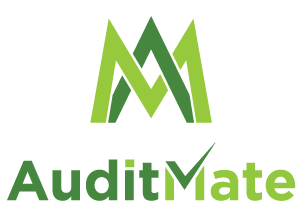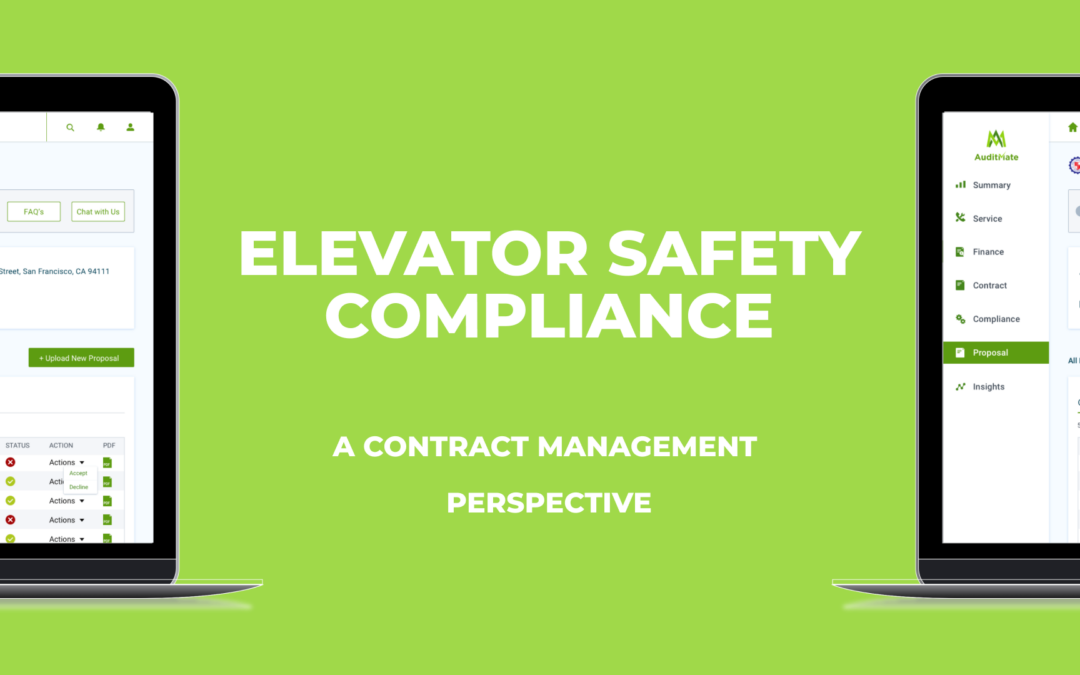Elevator Safety Compliance: A Contract Management Perspective
Imagine you’re the facilities manager at a high-rise office building. You’re responsible for keeping all systems running smoothly, including the elevators that hundreds of people rely on daily. Are you comfortable putting all your trust in the vendor? would you rather know that all the required safety testing is done and in compliance?
Elevator safety is serious business. With millions of people using elevators every day in the United States alone, injuries and fatalities from elevator accidents, though rare, highlight the need for strict compliance with maintenance, inspection, and reporting requirements.
For building owners and property managers, elevator safety involves balancing performance, cost, and managing relationships with multiple service vendors, while maintaining compliance. With numerous moving parts and players involved – OEMs, third-party service companies, inspectors, technicians – effective vendor and contract management are key to navigating this complex landscape.
Why Elevator Safety Matters
Elevators are vital to accessibility and functionality in mid- and high-rise buildings. They need to work properly to serve building occupants and visitors. Elevator accidents, though infrequent, can result in serious injury or death. High-profile incidents like the 2015 Manhattan elevator accident that killed an advertising executive point to the potentially catastrophic consequences of lapses in safety protocols.
While elevator accidents are rare relative to the number of elevator trips taken each day, data from the U.S. Bureau of Labor Statistics and Consumer Product Safety Commission highlight areas for improvement:
Over 9,000 elevator-related injuries are reported annually in the U.S. Fatalities, though declining, still occur at an average rate of about 30 per year. Improper maintenance, often tied to delayed repairs or missed inspections, is a major contributing factor. Injuries frequently result from doors closing on passengers, mechanical failures, and slips and falls.
Adhering to codes and standards is vital for safety. The American Society of Mechanical Engineers (ASME) A17.1 standard outlines mandatory safety requirements for inspection, testing, and maintenance. Local jurisdictions enforce compliance through annual inspections.
For elevators contractors and building owners, documenting proper maintenance and repairs for regulatory oversight is a crucial part of the safety equation.
Key Challenges for Building Owners
For building owners and managers, ensuring elevator safety requires navigating a complex web of equipment, service providers, and regulations. With answers hard to find across scattered paper trails and disjointed systems, proactive oversight is a challenge.
A data-driven approach, combining Internet of Things (IoT) monitoring, digital documentation, and automated notifications, can transform compliance from a reactive headache into a streamlined, risk-reducing process.
The High Costs of Non-Compliance
Industry statistics highlight the prevalence and risks of elevator accidents:
- Over 27,000 people are injured in elevator accidents each year in the U.S.
- 53% of elevator injuries involve doors closing on passengers
- Improper maintenance linked to delayed repairs causes 27% of injuries
- Fatalities average around 30 per year, typically caused by falls or mechanical failures
Liability costs can exceed $1 million per incident (5), creating substantial financial risk for building owners. Staying on top of inspections and maintenance mitigates this exposure.
Regulatory Landscape
Local jurisdictions enforce compliance to ASME 17.1 safety standards through annual third-party inspections. Inspectors evaluate:
- Maintenance logs, repair orders, and testing documents
- Functionality of:
- Doors and interlocks
- Braking systems
- Counterweights
- Control systems
- Safety devices (emergency stop, door sensors)
- Guide rails, cables, machine rooms
Deficiencies must be corrected quickly to avoid shutdown. Process gaps that lead to violations create significant operational disruptions and costs.
The Need for Data Centralization
To demonstrate compliance, building managers must assemble maintenance records from multiple original equipment manufacturers (OEMs) and third-party service technicians into comprehensive reports.With data scattered across paper files and digital systems, critical information often goes unseen, leading to negative inspection findings.
Cloud-based software centralizes documentation from all sources into one searchable database. Automated notifications can track renewal dates and prompt technicians to submit inspection reports.Digital documentation also enables predictive analytics using artificial intelligence to flag high-risk equipment and prevent failures before they occur.
The Potential of IoT-Connected Units
IoT-enabled elevators with embedded sensors provide continuous data on:
- Motor vibration patterns predictive of imminent failure
- Door and brake performance
- Usage levels to optimize maintenance timing
- Temperature changes indicating machine room issues
By establishing an IoT monitoring baseline, analytics can detect aberrations and notify technicians to address problems early. Combining IoT data with digital maintenance records provides inspectors a detailed performance picture.
Proactive Monitoring Over Reactive Response
For busy facility managers, managing multi-vendor compliance processes manually is near impossible. Lapses become inevitable. Software-driven solutions like centralized documentation, automated notifications, and IoT analytics overcome these gaps. They provide complete, easily accessible records for a building’s entire elevator portfolio.
With a unified data platform enabling proactive oversight, building owners can transform elevator safety programs from reactive fire drills into streamlined, risk-reducing processes. When compliance works in sync across people, records, and equipment, safety outcomes improve for the public.
Contractor Accountability
Hiring qualified vendors is one thing, but holding them accountable for consistently meeting reporting requirements and service delivery timelines is another matter. Limited visibility into compliance performance makes vendor management an uphill battle.
Inspection Readiness
Annual third-party inspections need extensive preparation. Inspectors expect comprehensive maintenance records and equipment access. Disorganization can lead to deficiencies or negative inspection reports.
Reporting & Documentation
Presenting accurate maintenance and inspection records to auditors and inspectors requires collating multiple data sources into consistent reports. Few property managers have the time or focus required to pull this all together manually.
When requirements slip, it creates liability risks for the building owner. A reactive, manual approach to managing elevator safety compliance is no longer sufficient in today’s climate of accountability.
The AuditMate Solution
AuditMate, a SaaS-based elevator audit software, offers a comprehensive solution to navigate these challenges. By providing data-driven auditing products, AuditMate simplifies vendor management, ensuring strict adherence to maintenance schedules and contracts.
With AuditMate, building owners and managers can:
Centralize Data – Cloud-based document storage and management eliminates scattered paper trails and computer files, providing one reliable data repository.
Standardize Reporting – Service providers submit comprehensive digital reports right from the field. Critical data is captured consistently.
Automate Notifications – Smart reminders keep inspection and maintenance timelines on track across multiple vendors.
Provide Oversight – Real-time status dashboards deliver visibility into compliance performance. Actionable insights help keep vendors accountable.
Prepare for Audits – Inspection checklists and comprehensive reports ensure readiness for annual audits.
Reduce Risk – Complete documentation trail demonstrates safety compliance and diligence.
Thousands of buildings and 60+ elevator service providers across North America already use AuditMate to ensure elevator safety compliance. The software pays for itself through time savings, improved contractor accountability, and reduced liability exposure.
Looking Ahead
The regulatory landscape for elevator safety will likely expand as Internet of Things sensor data provides more visibility into real-world equipment performance and usage. Expect a shift from outdated reactive approaches to proactive, predictive protocols that maximize safety and uptime.
For building owners and managers, a service management platform like AuditMate will be essential to navigate these changes. By establishing a solid foundation of data-driven contractor oversight and automated compliance today, they’ll be ready to adapt as technology and regulations evolve.
When it comes to safely transporting millions of people daily, compliance is paramount. With a proactive approach and the right tools, building owners and managers can effectively manage safety programs, reduce risks, and uphold public trust.

Frequently Asked Questions | AuditMate
FAQs
How often should we be inspecting our building’s elevators?
Most jurisdictions require yearly third-party safety inspections by certified professionals. Schedule regular inspections well in advance to allow time for addressing any issues.
What are the most common elevator code violations?
Missed maintenance logs, inadequate documentation, and faulty safety components like door mechanisms are frequent deficiencies. Staying organized and on top of repairs helps avoid violations.
How can we get our technicians to complete maintenance logs consistently?
Digital logging through a centralized platform like AuditMate streamlines recording, submitting, and accessing maintenance data for all parties.
What happens if we fail an elevator inspection?
The inspector will outline deficiencies to be corrected, often within 30 days to avoid fines or shutdown. Address issues promptly and thoroughly.
How much does an elevator safety management system cost?
Software-as-a-service systems like AuditMate generally have monthly subscription plans based on number of units. The ROI from operational efficiencies is substantial.

